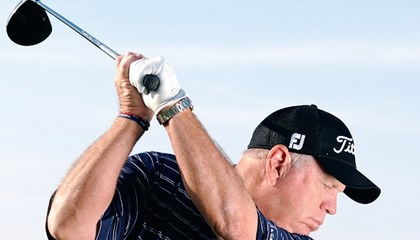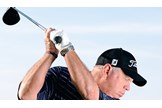Butch Harmon Power Instruction
Last updated:
Shorter + Wider = Longer
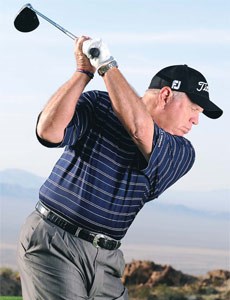
For control off the tee, do what my guys do: limit your backswing…
My top three tour guys – Phil Mickelson, Ernie Els and Adam Scott – all came to me with the same problem: too much backswing. They’d take the club back too far and then have to rely on super-fast hands to get it in position coming down. When they timed it right, they hit the ball a mile. But when they didn’t, they missed too many fairways. Average golfers who overswing don’t have the hands to save things on the way down. The result is poor contact and all kinds of bad shots. Here we’ll look at the two ways golfers overswing: (1) the arms swing too long, and (2) the body turns too much. I’ll teach you how to fix these faults for a shorter, wider backswing. Plus, I’ll show you the tips that helped my tour players use that shorter action to get back in control.
FAULT – The Arms Swing Too Long
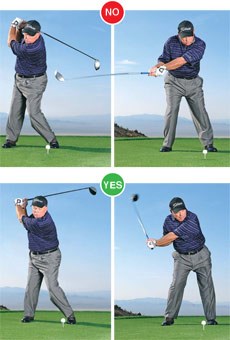
This is the more common of the two overswing faults. The arms keep swinging back after the body has stopped turning, causing them to collapse (top, far left). When this happens, the player tends to throw the club from the top, hanging back on the right side (top, left). This pushes the club onto an outside path, and the wrists unhinge too early. The typical result is a weak slice. Ernie and Adam had this problem, obviously to a lesser degree than you see in these pictures, but they did overswing, which required too much hand action on the way down.
THE FIX – Keep The Hands Away From The Head
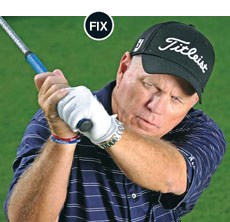
The way to avoid a long arm swing is to focus on pushing your hands away from your head. This simple thought promotes a wider arc, so you can easily swing the club back in front of your body on the downswing. Concentrate on keeping your right arm wide, which will keep your left arm wide.
ERNIE’S KEY – Turn The Chest All The Way Through
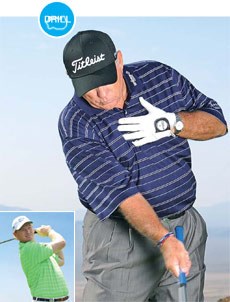
Ernie Els photo by David Cannon/Getty Images
Ernie used to slow down his upper body and do everything with his hands at impact. Once he learned to stay wide going back, his one thought became turning his chest through to the finish. The photo at right shows the move Ernie needed to feel: chest on top of the ball at impact and turning through.
ADAM’S KEY – Release The Head With The Swing
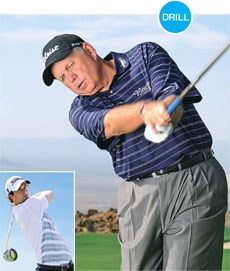
Adam Scott photo by Sam Greenwood/Getty Images
Adam had a different feel. He had to stop tilting away from the target on the downswing and flipping his hands past him. Once he got more centered, his thought was to turn his head through with the swing (left). Picture Annika or David Duval releasing their heads with the ball. This helped Adam to move everything forward together.
FAULT – The Body Turns Too Much
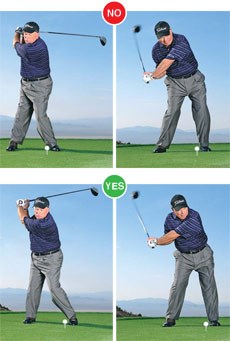
Though not as common as overswinging the arms, this fault plagues golfers who are flexible enough to overturn. Or, like Phil, players who let their back knee straighten, which allows the hips to turn more and the club to get “deep,” or behind the body (top, far left). When the average player does this, the legs often run out in front on the downswing, which causes the spine to tilt away from the target to counterbalance (top, left). Then the swing gets very narrow coming down — the club too close to the body — leading to an in-to-out path and pushes and hooks.
THE FIX – Keep The Back Knee Flexed To The Top
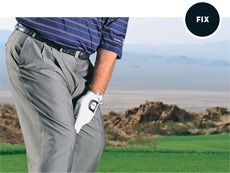
Maintaining the knee flex set at address is the master move here. It restricts the hip turn, which restricts upper-body turn. A more controlled rotation keeps the hands and arms from getting too deep. When they stay wide, they’re in position to swing the club back to swing the club back to the ball on a straighter path.
PHIL’S KEY – Drag The Back Heel Ahead Of The Toe
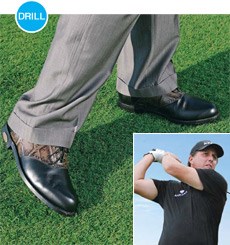
Phil Mickelson photo by Sam Greenwood/Getty Images
Phil had a tendency to overturn and then let his legs race ahead on the downswing. He’d spin out, and his back foot would pivot on its toes, the heel turning away from the target. The feel he needed was that his back heel was leading the toes as he came down, like he was dragging the heel forward (left). He also focused on his back knee gently coming toward his front knee — a much quieter leg action.
PHIL’S DRILL – Hit Short Irons Three-Quarters
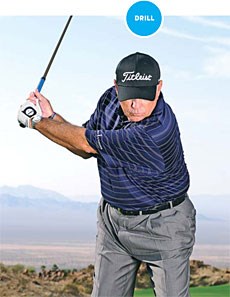
Well, it started out as a drill, but now it’s how Phil hits all his short irons. He makes a three-quarter backswing and keeps his legs passive coming down. I haven’t seen Phil make a full swing with a short iron all year. This is great advice for any golfer who tries to max out shorter clubs by swinging them like a driver. It’s much easier to match up the arm swing with the body turn coming down when the motion is shorter and wider going back. Try hitting some three-quarter short irons on the practice tee. I’ll bet you hit them so pure, you’ll take it right to the course, just like Phil did.
© GOLF DIGEST
